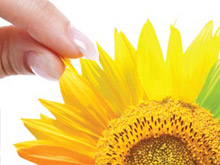Health Topics
-
Healthy Living
-
|
|
February 2010
|
| A Lowdown on Leprosy |
| Dr Sachin Varma |
| |
 |
For long, lepers have been social untouchables. Once detected with leprosy, they were abandoned by their family and had to beg for sustaining their painful existence. When walking along a path, lepers had to shout aloud to warn people to move out – or else… they were even stoned for this arrogance. |
As we've celebrated the World Leprosy Day on Jan 31st, let's do away with some common myths surrounding this disease
Leprosy continues to exist in our society and affects those around us, how much ever we'd like to wish the disease away. Africa, South-East Asia and India are still contributors to the largest number of new cases reported of leprosy in the world. But thankfully, perceptions about leprosy have changed a lot with more people becoming aware that like any other disease, leprosy too can be cured, with proper treatment.
2 Leprosy Myths
What makes leprosy stand out from other diseases are the myths, stigma and fears prevalent in society about it.
Myth #1
Leprosy is transmitted by shaking hands or sharing utensils of those suffering from the disease: Though it is true that leprosy is a communicable disease, it is very difficult indeed to catch the disease - and it certainly cannot be caught - by a handshake and by eating from the same utensils. Leprosy is caused by a bacterium called Mycobacterium leprae. It is spread by the transmission of airborne droplets – coughing and sneezing! And more than 95 percent of people are actually immune to this disease! It is the immune handling of the Leprae bacterium that either brings about the disease or keeps it at bay.
Also, after initiation of Multi Drug Therapy (MDT), sufferers of this disease become non-infectious. So you don't have to be scared to interact with people who are undergoing regular treatment.
Myth #2
Fingers and toes drop off to make a leprosy-afflicted person disabled for life: Leprosy attacks cooler surfaces and surface nerves of the body, destroying them. The skin areas supplied by these nerves thus get anaesthetised, unable to feel any pain. These can then easily become injured by cuts, hot substances falling on them or bruises. Infection can also set in easily, destroying them. But these are all only late sequels of this disease, which happen only if proper care is not taken - and after nerve destruction has set in. If leprosy is diagnosed early and proper care is taken of the anaesthetised area, these don't have to happen. That is precisely why early diagnosis and treatment is so vital.
| In 1981, when leprosy was at its peak in India, the Prevalence Rate (PR) was 57 per 10,000 population. In March 2008, it fell to 0.74! The number of patients under treatment was about 40,00,000 then - it is about 87,000 now. In 1991, the World Health Assembly passed a resolution to 'Eliminate Leprosy as a Public Health Problem', defined as reaching a prevalence of less than one per 10,000 population. India achieved this goal at the end of the year 2005. |
| |
3 Symptoms of Leprosy
The Leprae bacterium has a long incubation period ranging in years, and the first outward sign of leprosy is a patch on the skin, usually associated with loss of feeling. Watch out for these cardinal signs:
- One or more hypopigmented, anaesthetised (dead) skin patches, typical of leprosy
- One or more thickened peripheral nerves
- Sample of material is collected from a tiny cut in the skin and then stained for M. Leprae, an acid-fast bacillus. A positive skin smear confirms leprosy.
Leprosy essentially goes by clinical diagnosis, although a laboratory test (the slit skin smear) is important in some cases. |
Leprosy is also known as Hansen's Disease, after the Norwegian doctor Armauer Hansen, who was the first to view the leprosy microbe under a microscope in 1873
Leprosy is Curable
With the advent of Multi Drug Therapy (MDT) in 1981, a powerful combination of two to three drugs - Clofazimine, Rifampicin and Dapsone - leprosy has become curable. Mild, non-infectious cases of leprosy need treatment with two drugs for six months. More severe infectious cases need all three drugs for a 12 to 24 month period. There is, however, no effective preventive vaccine - which is why early detection and treatment with MDT is so vital.
One of the major challenges in leprosy management is early detection of the disease before the nerve damage and disability sets in. Removing stigmas attached to leprosy, making medicines and care easily accessible to those with the disease; and working on the housing and other conditions responsible for bacterial survival are key factors to manage this oncefeared disease.
At a recently held Global Leprosy Programme Managers' meeting, it was targeted to reduce new leprosy cases with grade 2 disabilities by at least 35 percent of the current year, by the end of 2015.
Dignity Despite Deformities
The number of people affected by leprosy (including those who have completed their medical treatment but have a disability, or still stigmatised) remains very high – at around 3 million! People affected by leprosy need more than just medicine. They require confidence training rehabilitation and absorption back into the society with vocational training, so that they can lead independent lives with confidence. Mother Theresa and the Missionaries of Charity, among many other organisations and initiatives (including the National Leprosy Eradication Programme), showed the world that they would hug, clean the wounds and take care of these 'untouchables', to show them that God has made them too, in His own image. It is such unconditional love, more than a lot of other things, that every patient deserves! |
 |
Dr. Sachin Varma is Consultant Dermatologist at Apollo Gleneagles Hospitals, Kolkota |
|
|